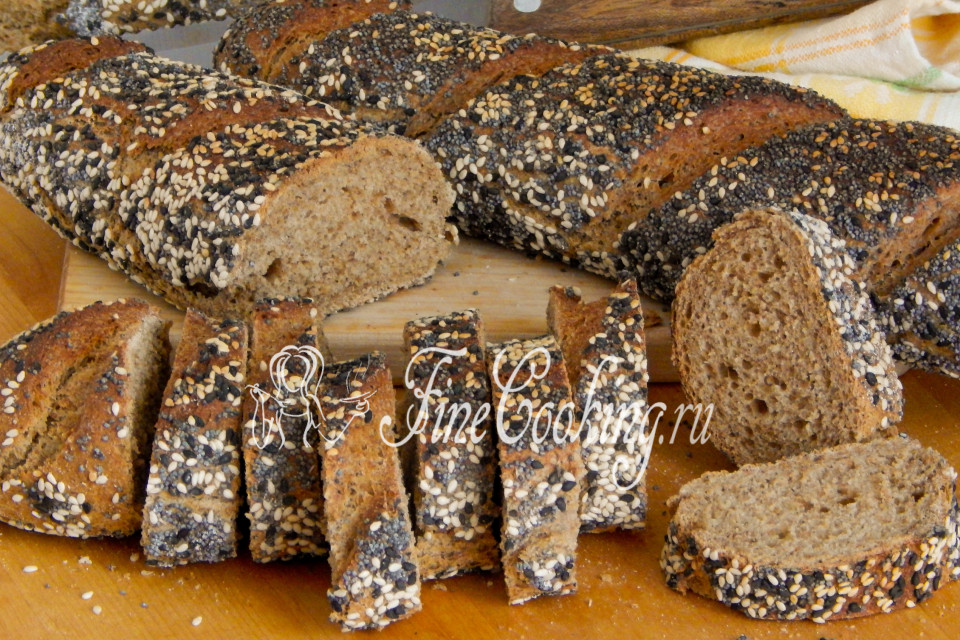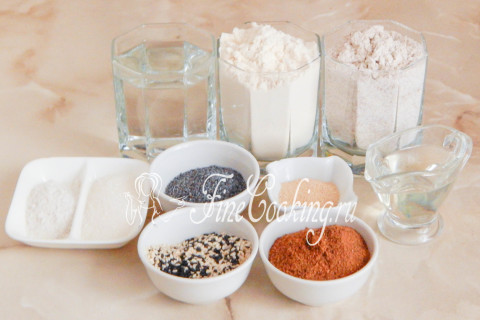Step 1
For the preparation of home wheat-rzhany baust, we will need the following ingredients: wheat flour (higher or first grade), rye flour (I have a peeling, but graceful or wallpaper), water, fermented (red) rye malt, salt, sugar, refined vegetation (I use sunflower) oil and rapidly acting) yeast. For sprinkle, take a poppy and sesame seeds (I have a mixture of black and white, but this is not fundamentally, one can be one). I use the shiver of fast -acting (added immediately to flour), but you can take dry (in the same amount — 1.5 teaspoons are 5 grams) or fresh (pressed, wet) — then they will need exactly three times more, that is, 15 grams. Such yeast is previously diluted in warm water with sugar and left for 10-15 minutes to activate (the foam cap should rise).
Step 2
First of all, you need to brew rye malt. To do this, put two tablespoons of malt in a bowl and fill it with 50 milliliters of boiling water. Actively stir everything to get a thick mass. Let the brewed malt cool to room temperature. Undoubtedly, you can use dry malt (add with the rest of the ingredients to flour), but thanks to brewing, finished home bread is more fragrant.
Step 3
Then we sift 300 grams of wheat flour and 150 grams of rye flour into a suitable dish. Sifting is necessary solely in order to get rid of possible particles of garbage in flour. Sharp the dough will be yeast.
Step 4
Add a teaspoon of salt to flour, a tablespoon of sugar and one and a half teaspoons of high yeast. If you have dry (1.5 teaspoon) or pressed (15 grams) yeast, they will need to be previously diluted in warm water (100 milliliters from the total volume) with sugar and let stand for 10-15 minutes. Mix everything thoroughly with a spoon or hand so that all the ingredients are uniformly connected.
Step 5
We make a hole in the flour and pour 260 milliliters of slightly warm water into it. We also send in advance a brewed rye malt.
Step 6
Mix so that the flour absorbs the liquid. Only then we add one and a half tablespoons of refined vegetable oil (we leave half the spoon to lubricate the bowl so that the dough does not stick to it).
Step 7
We knead the dough for wheat-rugal baguits with our hands, in the test or in the bread machine. The dough should be quite soft, but at the same time it is excellent to keep shape and not spread. If for some reason your dough is too moist and does not hold shape, add a little more flour (wheat or rye — it does not matter). The fact is that the ability of moisture is different in each flour, so it may need more or less. The dough sticks a little to the hands — this is normal. We round the dough and put in a bowl, which is slightly lubricated with the remains of vegetable oil.
Step 8
Tighten the bowl with a cling film or cover with a towel and leave in a warm place for an hour and a half. After 45 minutes, gently crush the dough to release excess gas from it, round and give another 45 minutes to ferment. After an hour and a half (total time), the dough for wheat-rusty baguettes should increase 2.5-3 times in volume. Where is it better to wander the test and what does a warm place mean? There are several options. First of all, in the oven with a light bulb turned on (it turns out about 28-30 degrees — the temperature ideal for fermentation of yeast dough). Then we tighten the bowl with the dough with cling film or cover with a towel made of natural fabric (flax is best suited) so that the surface does not be swollen and not covered with a crust. You can also let the dough wander in a microwave, in which we pre -boil a glass of water. The dough will rise with a door closed, and the glass will stand there. Then the bowl does not need to be closed with anything, since the water will evaporate, thereby maintaining the necessary humidity. Just make sure that no one inadvertently turns on the microwave, otherwise the dough will disappear and there will be no bread.
Step 9
When the dough is suitable, divide it into 3 equal (I have 277 grams) of the part to get as many baguettes. You can, of course, make two baguits, but then they are unlikely to fit on a standard baking sheet.
Step 10
Sprinkle the working surface slightly with rye flour (its number in the ingredients is not indicated) and with our hands we knead one part of the dough into a not very thin layer. The other two so far we will cover with a towel so that they do not be swollen and not covered with a crust.
Step 11
Then visually divide this layer in half. Fold the far edge of the dough to the middle and the fast movement of the rib of the palm of the palm we seal the seam.
Step 12
After that, we turn the workpiece 180 degrees and repeat the similar action. I pinched the seam with my fingers, it’s more convenient.
Step 13
Now fold the dough in half over the seam and again fasten the seam by the edge of the palm ..
Step 14
We roll the workpiece on the table, giving it the shape of a long and thin baguette. We also do with the rest of the two parts of the dough.
Step 15
Now the most interesting (in any case is for me) — we will collapse our future wheat -rusty baguettes in panning. We generously pour a poppy and sesame seeds on the table, having previously mixed them. We invite the dough preparation with your wet hands so that the surface is moisturized and sprinkling to it stuck well. We run the future baguette in sprinkle so that almost the entire surface is covered with poppy seeds and sesame seeds. In the same way, we collapse the other two blanks in poppy and sesame.
Step 16
Further, our future baguettes need to relax and distance. To do this, take a linen (or from another natural fabric) a towel, rub it very carefully with rye flour, so that then the blanks do not stick. We put future baguettes on a towel at a distance from each other.
Step 17
We pull the workpieces almost close, making the folds between them. What is it for? Everything is simple: in the process of parting, the dough will grow and increase in volume, but in order for it to grow up, and does not spread into the sides, we make such a design. We cover the blanks with the remaining part of the towel so that the dough does not dry. We leave for an hour and a half for lifting in a warm place. It is most convenient to place them in the oven with a light bulb turned on.
Step 18
When the workpieces swell noticeably, we transfer them to a baking sheet covered with baking paper. You can shake off excess flour from blanks with a brush.
Step 19
Now we make rather deep incisions with a sharp knife or blade so that they open during the baking, while the baguettes do not crack. Before planting in the oven, spray the blanks of water from the spray gun.
Step 20
We bake wheat-rusty baguettes in a preheated oven for the first 10 minutes at 250 degrees, throwing a couple of ice cubes to the bottom. That is, bag baguettes with steam. Then we reduce the temperature to 200 degrees and bug the baguettes to a rosy state for another 25-30 minutes without a pair.
Step 21
We remove ready-made wheat-ruddy baguettes from a baking sheet and cool on a grille so that the bottom is not cutting off due to condensation.
Step 22
It is best to cut wheat-rusty baguettes after 2-3 hours (you can) since their readiness. Unusually crispy crust, soft, small -hovered crumb, wonderful taste and an rye aroma of this home bread will barely leave you indifferent.






















